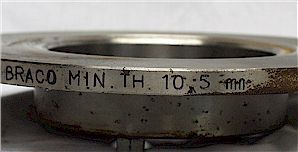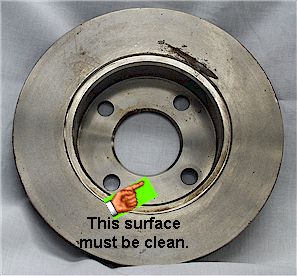Brake Rotor Tips |
|
| Background | |
| This is a collection of my thoughts and experiences regarding SRF brake rotors. While this may seem mundane, there’s speed here. | |
| Rotor Setup | |
| New
Rotor Prep The first thing you’ll want to do to your new rotors is turn them down to the minimum thickness. The rules allow the rotors to be as thin as 10.5 mm. If you closely inspect your rotors you’ll find a minimum thickness spec stamped or cast in the rotor.  Regardless of the rules, I would not turn the rotors
thinner than the manufacturer’s minimum spec. The picture here shows the new
“06 90 B” BRACO rotors I got with chassis #630. As you can see, the spec
is stamped on the edge as 10.5 mm. Regardless of the rules, I would not turn the rotors
thinner than the manufacturer’s minimum spec. The picture here shows the new
“06 90 B” BRACO rotors I got with chassis #630. As you can see, the spec
is stamped on the edge as 10.5 mm. The
reasons for turning the rotors down are: Break-In |
|
| Miscellaneous Rotor Tips | |
| Seating
Surface Many people experience significant brake drag. The most common reason is that the caliper pins are bound up. (See the article “Brake Maintenance” for info) Another common reason is that the rotor is not running true -- that it is out-of-round or wobbling. This out-of-round behavior causes the rotor to drag against the pads for part of the rotation. The most common cause of this that I’ve found is dirt on the back mounting surface of the rotor.  Referring to the picture, you want to make sure
that the rotor mounting surface is clean. If any dirt gets between this mounting
surface and the hub, the rotor will run out-of-round. Whenever you remove your
rotors, or if you have big brake drag, clean this surface. Referring to the picture, you want to make sure
that the rotor mounting surface is clean. If any dirt gets between this mounting
surface and the hub, the rotor will run out-of-round. Whenever you remove your
rotors, or if you have big brake drag, clean this surface.Warped Rotors |
|
Rev. 7/4/98 |
|
